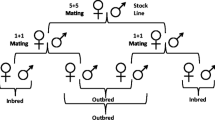Summary
An experiment was performed to test the hypothesis that the genetic distance between populations estimated from enzyme loci could be used to predict the amount of heterosis that would occur in crosses between these populations. A partial diallel cross using 11 populations of Drosophila melanogaster from the AustralianPacific region and from England was carried out. Heterosis for larval viability, fecundity, cold shock mortality, and an index of these three traits was recorded. When two populations originating from the same location were crossed, no heterosis occurred, but otherwise heterosis was significant for all traits. For larval viability, a similar low level of heterosis occurred in all crosses. For cold shock mortality, the level of heterosis varied widely and fecundity showed a pattern intermediate between these two. The geographic distance between the sites from which populations originated was not correlated with the amount of heterosis in their crosses. There was a tendency for populations from ecologically different environments to show heterosis in crosses. Genetic distance based on ten enzyme loci was correlated with heterosis for cold shock mortality and the combined trait index. These results can be explained by the hypothesis that genes affecting larval viability are subject to strong, uniform selection in all populations, which limits the extent to which gene frequencies can drift apart. However, genes affecting cold shock mortality and the enzyme loci are subject to different selection pressures in different environments. This divergent selection combined with genetic drift causes divergence in gene frequency and heterosis.
Similar content being viewed by others
References
Anderson PR (1981) Geographic clines and climatic associations of Adh and 6-gpdh gene frequencies in Drosophila melanogaster. In: Gibson JB, Oakeshott JG (eds) Genetic studies of Drosophila populations. Proceedings of the Kiola Conference, pp 237-250
Bonnier G (1961) Experiments on hybrid superiority in Drosophila melanogaster. I. Egg laying capacity and larval survival. Genetics 46:9–24
Bouletreau-Merle J, Allemand R, Cohet Y, David JR (1982) Reproductive strategy in Drosophila melanogaster: significance of a genetic divergence between temperate and tropical populations. Oecologia 53:323–329
Crow J, Kimura M (1970) An introduction to population genetics theory. Harper and Row, New York
Ehiobu NG (1985) The prediction of heterosis. PhD thesis. Graduate School of Tropical Veterinary Science, James Cook University of North Queensland, Townsville, Australia
Ehiobu NG, Goddard ME (1989) Heterosis in crosses between lines of Drosophila melanogaster selected for adaptation to different environments. Theor Appl Genet 77:253–259
Ehiobu NG, Goddard ME, Taylor JF (1989) Effect of rate of inbreeding on inbreeding depression of Drosophila melanogaster. Theor Appl Genet 77:123–127
Ehiobu NG, Goddard ME, Taylor JF (1990) Prediction of heterosis in crosses between inbred lines of Drosophila melanogaster. Theor Appl Genet 80
Franklin IR (1981) An analysis of temporal variation at isozyme loci in Drosophila melanogaster. In: Gibson JG, Oakeshott JG (eds) Genetic studies of Drosophila populations. Proceedings of the Kiola Conference, pp 217-236
Glodek P (1974) Specific problems of breed evaluation and crossings in pigs. In: Proc Working Symp Breed Evaluation and Crossing Exp with Farm Animals. Schoonoord, Zeist: Research Institute of Animal Husbandry, pp 267
Goddard ME, Ahmed AM (1982) The use of the genetic distance between cattle breeds to predict the heterosis in crosses. Proc 2nd World Congr Genet Appl Livestock Prod, Madrid, Spain
Graml R, Pirchner F (1984) Relation of genetic distance between cattle breeds and heteroses of resulting crosses Anim Blood Groups Biochem Genet 15:173–180
Moll RH, Lonnquist JH, Velez Fortuno J, Johnson EC (1965) The relationship of heterosis and genetic divergence in maize. Genetics 52:139–144
Oakeshott JG, Chambers GK, Gibson JW, Willcocks DA (1981) Latitudinal relationships of esterase-6 and phosphoglucomutase gene frequencies in Drosophila melanogaster. Heredity 47:385–396
Oakeshott JG, Gibson JB, Anderson PR, Knibb WR, Anderson DG, Chambers GK (1982) Alcohol dehydrogenase and glycero-3-phosphate dehydrogenase clines in Drosophila melanogaster on different continents. Evolution 36:86–96
Oakeshott JG, Chambers GK, Gibson JB, Eanes WF, Wilcocks DA (1983a) Geographic variation in G-6-pgh and pgd allele frequencies in Drosophila melanogaster. Heredity 50:67–72
Oakeshott JG, Gibson JB, Willcocks DA, Chambers GK (1983b) Latitudinal variation in octanol dehydrogenase and acid phosphatase allele frequencies in Drosophila melanogaster. Theor Appl Genet 65:191–196
Singh RS, Rhomberg LR (1987) A comprehensive study of genie variation in natural populations of Drosophila melanogaster. I. Estimates of gene flow from rare alleles. Genetics 115:313–322
Singh RS, Hinkey DA, David J (1982) Genetic differentiation between geographically distant populations of Drosophila melanogaster. Genetics 101:235–256
Wallace B (1966) Distance and allelism of lethals in a tropical population of Drosophila melanogaster. Am Nat 100:565–578
Yamazaki T, Choo JK, Watanabe TK, Takahata N (1986) Gene flow in natural population of Drosophila melanogaster with special reference to lethal allelism rates and protein variation. Genetics 113:73–79
Author information
Authors and Affiliations
Additional information
Communicated by J. S. F. Barker
Rights and permissions
About this article
Cite this article
Ehiobu, N.G., Goddard, M.E. Heterosis in crosses between geographically separated populations of Drosophila melanogaster . Theoret. Appl. Genetics 80, 569–575 (1990). https://doi.org/10.1007/BF00226762
Received:
Accepted:
Issue Date:
DOI: https://doi.org/10.1007/BF00226762




